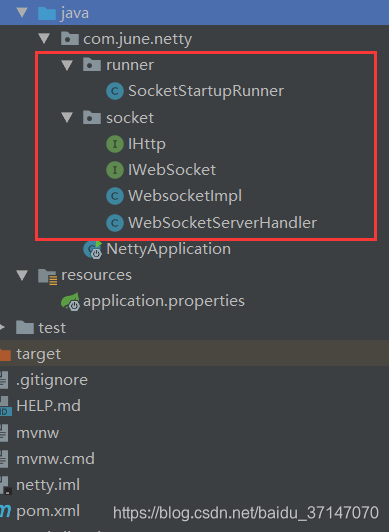基于netty的多人单聊天室
最近正好公司需要做一个聊天室的功能,所以就选择用netty做一个聊天室,觉得蛮有意思的,netty是一个非常优秀的框架,在之后的文章中会整理出有关netty学习的文章。
项目要求做的是多人多个聊天室,目前大多数项目中需要的是多人多聊天室,我是采用的redis实现的多聊天室,万事都要循序渐进,这篇文章先分享一下多人单聊天室的功能实现,后续的文章中会分享多人多聊天室的功能实现。
项目使用的是springboot,然后把socket初始化放在项目启动之后,而不是网上广为流传的使用另外的main方法启动,下图是主要文件:

本着面向接口编程的思想,把http和websocket的两个方法抽到了接口文件中,首先是 IHttp接口:
package com.june.netty.socket; import io.netty.channel.ChannelHandlerContext; import io.netty.handler.codec.http.FullHttpRequest; public interface IHttp { void handleHttpRequset(ChannelHandlerContext ctx, FullHttpRequest request); }
IWebSocket接口:
package com.june.netty.socket; import io.netty.channel.ChannelHandlerContext; import io.netty.handler.codec.http.websocketx.TextWebSocketFrame; public interface IWebSocket { void textdoMessage(ChannelHandlerContext ctx, TextWebSocketFrame msg); }
然后是实现类WebsocketImpl,实现了IHttp和IWebSocket两个接口,关于消息的发送方法和初始化方法就在这个类中:
package com.june.netty.socket; import com.alibaba.fastjson.JSON; import com.google.gson.Gson; import io.netty.bootstrap.ServerBootstrap; import io.netty.channel.*; import io.netty.channel.group.ChannelGroup; import io.netty.channel.group.DefaultChannelGroup; import io.netty.channel.nio.NioEventLoopGroup; import io.netty.channel.socket.nio.NioServerSocketChannel; import io.netty.handler.codec.http.FullHttpRequest; import io.netty.handler.codec.http.HttpHeaderNames; import io.netty.handler.codec.http.HttpObjectAggregator; import io.netty.handler.codec.http.HttpServerCodec; import io.netty.handler.codec.http.websocketx.TextWebSocketFrame; import io.netty.handler.codec.http.websocketx.WebSocketServerHandshaker; import io.netty.handler.codec.http.websocketx.WebSocketServerHandshakerFactory; import io.netty.handler.stream.ChunkedWriteHandler; import io.netty.util.AttributeKey; import io.netty.util.concurrent.GlobalEventExecutor; import java.util.HashMap; import java.util.Map; import java.util.concurrent.ConcurrentHashMap; public class WebsocketImpl implements IHttp,IWebSocket{ private static final String HN_HTTP_CODEC = "HN_HTTP_CODEC"; private static final String NH_HTTP_AGGREGATOR ="NH_HTTP_AGGREGATOR"; private static final String NH_HTTP_CHUNK = "HN_HTTP_CHUNK"; private static final String NH_SERVER = "NH_LOGIC"; private static final AttributeKey<WebSocketServerHandshaker> ATTR_HANDSHAKER = AttributeKey.newInstance("ATTR_KEY_CHANNELID"); private static final int MAX_CONTENT_LENGTH = 65536; private static final String WEBSOCKET_URI_ROOT_PATTERN = "ws://%s:%d"; //websocket地址 private String host; //websocket端口号 private int port; //存放websocket连接 private Map<ChannelId, Channel> channelMap = new ConcurrentHashMap<ChannelId, Channel>(); private ChannelGroup group = new DefaultChannelGroup(GlobalEventExecutor.INSTANCE); private final String WEBSOCKET_URI_ROOT; public WebsocketImpl(String host, int port) { super(); this.host = host; this.port = port; WEBSOCKET_URI_ROOT = String.format(WEBSOCKET_URI_ROOT_PATTERN, host, port); } //socket初始化方法 public void start(){ EventLoopGroup bossGroup = new NioEventLoopGroup(); EventLoopGroup workerGroup = new NioEventLoopGroup(); ServerBootstrap sb = new ServerBootstrap(); sb.group(bossGroup, workerGroup); sb.channel(NioServerSocketChannel.class); sb.childHandler(new ChannelInitializer<Channel>() { @Override protected void initChannel(Channel ch) throws Exception { // TODO Auto-generated method stub ChannelPipeline pl = ch.pipeline(); //保存引用 channelMap.put(ch.id(), ch); group.add(ch); ch.closeFuture().addListener(new ChannelFutureListener() { @Override public void operationComplete(ChannelFuture future) throws Exception { // TODO Auto-generated method stub //关闭后抛弃 channelMap.remove(future.channel().id()); group.remove(ch); } }); pl.addLast(HN_HTTP_CODEC,new HttpServerCodec()); pl.addLast(NH_HTTP_AGGREGATOR,new HttpObjectAggregator(MAX_CONTENT_LENGTH)); pl.addLast(NH_HTTP_CHUNK,new ChunkedWriteHandler()); pl.addLast(NH_SERVER,new WebSocketServerHandler(WebsocketImpl.this,WebsocketImpl.this)); } }); try { ChannelFuture future = sb.bind(host,port).addListener(new ChannelFutureListener() { @Override public void operationComplete(ChannelFuture future) throws Exception { // TODO Auto-generated method stub if(future.isSuccess()){ System.out.println("websocket started"); } } }).sync(); future.channel().closeFuture().addListener(new ChannelFutureListener() { @Override public void operationComplete(ChannelFuture future) throws Exception { // TODO Auto-generated method stub System.out.println("channel is closed"); } }).sync(); } catch (InterruptedException e) { // TODO Auto-generated catch block e.printStackTrace(); } finally{ bossGroup.shutdownGracefully(); workerGroup.shutdownGracefully(); } System.out.println("websocket stoped"); } @Override public void handleHttpRequset(ChannelHandlerContext ctx, FullHttpRequest request) { String subProtocols = request.headers().get(HttpHeaderNames.SEC_WEBSOCKET_PROTOCOL); WebSocketServerHandshakerFactory factory = new WebSocketServerHandshakerFactory(WEBSOCKET_URI_ROOT, subProtocols, false); WebSocketServerHandshaker handshaker = factory.newHandshaker(request); if(handshaker == null){ WebSocketServerHandshakerFactory.sendUnsupportedVersionResponse(ctx.channel()); }else{ handshaker.handshake(ctx.channel(), request); ctx.channel().attr(ATTR_HANDSHAKER).set(handshaker); } return; } @Override public void textdoMessage(ChannelHandlerContext ctx, TextWebSocketFrame msg) { Map<String,Object> maps = (Map) JSON.parse(msg.text()); String value = (String) maps.get("msg"); Map<String,String> backMap = new HashMap<String,String>(); backMap.put("msg",value); Gson gson = new Gson(); group.writeAndFlush(new TextWebSocketFrame(gson.toJson(backMap))); } }
然后是消息的接收方法类:
package com.june.netty.socket; import io.netty.channel.ChannelHandlerContext; import io.netty.channel.SimpleChannelInboundHandler; import io.netty.handler.codec.http.FullHttpRequest; import io.netty.handler.codec.http.websocketx.TextWebSocketFrame; public class WebSocketServerHandler extends SimpleChannelInboundHandler<Object>{ private IWebSocket iWebSocket; private IHttp iHttp; public WebSocketServerHandler(IWebSocket iWebSocket, IHttp iHttp) { super(); this.iWebSocket = iWebSocket; this.iHttp = iHttp; } @Override protected void channelRead0(ChannelHandlerContext ctx, Object msg) throws Exception { // TODO Auto-generated method stub if (msg instanceof TextWebSocketFrame){ iWebSocket.textdoMessage(ctx,(TextWebSocketFrame)msg); }if(msg instanceof FullHttpRequest){ iHttp.handleHttpRequset(ctx, (FullHttpRequest)msg); } } @Override public void channelReadComplete(ChannelHandlerContext ctx) throws Exception { // TODO Auto-generated method stub ctx.flush(); } }
最后是随着项目一起启动和初始化websocket的类SocketStartupRunner
package com.june.netty.runner; import com.june.netty.socket.WebsocketImpl; import org.springframework.boot.CommandLineRunner; import org.springframework.core.annotation.Order; import org.springframework.stereotype.Component; @Component @Order(value = 2) public class SocketStartupRunner implements CommandLineRunner { @Override public void run(String... args) throws Exception { WebsocketImpl socket = new WebsocketImpl("localhost", 8009); socket.start(); } }
关于pom.xml文件中的配置,主要的是netty的包,因为后续还有别的功能,所以里面多余的包可以看自己情况去掉:
<?xml version="1.0" encoding="UTF-8"?> <project xmlns="http://maven.apache.org/POM/4.0.0" xmlns:xsi="http://www.w3.org/2001/XMLSchema-instance" xsi:schemaLocation="http://maven.apache.org/POM/4.0.0 http://maven.apache.org/xsd/maven-4.0.0.xsd"> <modelVersion>4.0.0</modelVersion> <parent> <groupId>org.springframework.boot</groupId> <artifactId>spring-boot-starter-parent</artifactId> <version>2.1.7.RELEASE</version> <relativePath/> <!-- lookup parent from repository --> </parent> <groupId>com.june</groupId> <artifactId>netty</artifactId> <version>0.0.1-SNAPSHOT</version> <name>netty</name> <description>Demo project for Spring Boot</description> <properties> <project.build.sourceEncoding>UTF-8</project.build.sourceEncoding> <project.reporting.outputEncoding>UTF-8</project.reporting.outputEncoding> <java.version>1.8</java.version> <fastjson.version>1.2.15</fastjson.version> </properties> <dependencies> <dependency> <groupId>org.springframework.boot</groupId> <artifactId>spring-boot-starter-data-redis-reactive</artifactId> </dependency> <dependency> <groupId>org.springframework.boot</groupId> <artifactId>spring-boot-starter-websocket</artifactId> </dependency> <dependency> <groupId>org.springframework.boot</groupId> <artifactId>spring-boot-starter-test</artifactId> <scope>test</scope> </dependency> <!-- fastjson json --> <dependency> <groupId>com.alibaba</groupId> <artifactId>fastjson</artifactId> <version>${fastjson.version}</version> </dependency> <dependency> <groupId>org.springframework</groupId> <artifactId>spring-test</artifactId> <scope>compile</scope> </dependency> <!-- spring security --> <dependency> <groupId>io.jsonwebtoken</groupId> <artifactId>jjwt</artifactId> <version>0.7.0</version> </dependency> <dependency> <groupId>redis.clients</groupId> <artifactId>jedis</artifactId> <version>2.8.1</version> </dependency> <dependency> <groupId>com.google.guava</groupId> <artifactId>guava</artifactId> <version>18.0</version> </dependency> <dependency> <groupId>com.google.code.gson</groupId> <artifactId>gson</artifactId> <version>${gson.version}</version> </dependency> <dependency> <groupId>commons-io</groupId> <artifactId>commons-io</artifactId> <version>2.5</version> </dependency> <dependency> <groupId>io.netty</groupId> <artifactId>netty-all</artifactId> <version>4.1.6.Final</version> </dependency> </dependencies> <build> <plugins> <plugin> <groupId>org.springframework.boot</groupId> <artifactId>spring-boot-maven-plugin</artifactId> </plugin> </plugins> </build> </project>
这些是后台的代码,启动后console打印websocket started,表示已经启动成功了。
然后是前端的静态页面,随手写了一个简单的h5文件,没写样式比较丑,但是实现了功能,也有在vue中实现的,会在后续的多聊天室中补上
<!DOCTYPE html PUBLIC "-//W3C//DTD XHTML 1.0 Transitional//EN" "http://www.w3.org/TR/xhtml1/DTD/xhtml1-transitional.dtd"> <html xmlns="http://www.w3.org/1999/xhtml"> <head> <meta http-equiv="Content-Type" content="text/html; charset=utf-8" /> <title></title> </head> </head> <script type="text/javascript"> var socket; if(!window.WebSocket){ window.WebSocket = window.MozWebSocket; } if(window.WebSocket){ socket = new WebSocket("ws://localhost:8009"); socket.onmessage = function(event){ appendln("收到:" + JSON.parse(event.data).msg); }; socket.onopen = function(event){ appendln("链接已打开"); }; socket.onclose = function(event){ appendln("链接已关闭"); }; }else{ alert("链接丢失"); } function send(message){ if(!window.WebSocket){return;} if(socket.readyState == WebSocket.OPEN){ var messages = {"name": "admin","msg":message} socket.send(JSON.stringify(messages)); appendln("发送:" + message); }else{ alert("发送失败,链接丢失"); } } function appendln(text) { var ta = document.getElementById('responseMsg'); ta.value += text + "\r\n"; } function clear() { var ta = document.getElementById('responseMsg'); ta.value = ""; } </script> <body> <form onSubmit="return false;"> <input type = "text" name="message" value="你好啊,朋友"/> <br/><br/> <input type="button" value="send" onClick="send(this.form.message.value)"/> <hr/> <h3>聊天室</h3> <textarea id="responseMsg" style="width: 1000px;height: 600px;"></textarea> </form> </body> </html>
下面是效果图,第一个人发送消息:

第二个人看到的:

到这里,一个简单的聊天室就完成了,这是多人单聊天室,多人多聊天室也不难,有很多方式实现,我用的是redis,会在后续的文章中更新,代码的不足之处,还请指正。
🌈😀路漫漫其修远兮
吾将上下而求索😀🌈


 浙公网安备 33010602011771号
浙公网安备 33010602011771号